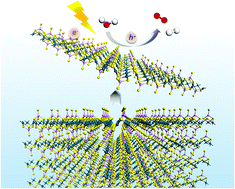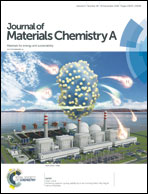Two-dimensional Pd3P2S8 semiconductors as photocatalysts for the solar-driven oxygen evolution reaction: a theoretical investigation†
Abstract
On the basis of first principles calculations, we propose Pd3P2S8 monolayer and bilayer, two-dimensional semiconductors, whose layered bulk parent crystals are experimentally reported, as promising photocatalysts for the solar-driven oxygen evolution reaction. The monolayer is kinetically and thermodynamically stable and shows a small cleavage energy of 0.35 J m−2, suggesting that it can be prepared by exfoliation from its bulk material, and exhibits a direct band gap of 2.98 eV, which can be engineered by applying strain. The Pd3P2S8 bilayer is an indirect band gap semiconductor with a slightly smaller band gap of 2.83 eV. The photoexcited holes generate favorable driving forces for promoting the specific solar-driven O2 evolution reaction. The extraordinary electronic properties, pronounced light harvesting capability in the visible and ultraviolet regions and active surface sites render the Pd3P2S8 monolayer and bilayer as compelling 2D materials with interesting application potential for photocatalytic and photoelectrocatalytic water splitting.



 Please wait while we load your content...
Please wait while we load your content...